Cloud solutions can maximize the benefits of data reliability, availability, AI innovation, data analytics, and meeting compliance requirements. Gartner expects that “70% of workloads will be hosted in the public cloud” by 2025, thus requiring a cloud security solution investment. Even if an all-cloud initiative is not in motion, it’s likely your organization will be moving operations into the cloud in the near future.

This is why the traditional username and password combination is often inadequate to protect user accounts from cyber attacks. As remote work becomes more common, businesses are opting to store their sensitive data in the cloud. It’s critical to understand that every business, big or small, has valuable information stored in cloud-based applications, making them vulnerable to cyberattacks. Zero Trust, for example, promotes a least privilege governance strategy whereby users are only given access to the resources they need to perform their duties. Similarly, it calls upon developers to ensure that web-facing applications are properly secured.
How We Evaluated the Top Cloud Security Companies
CSPM tools are a good choice for organizations oriented aroundInfrastructure, Software, and Platform as a Service and looking to automate security management. Unlike SSPM solutions, CSPM tools focus on controlling access to cloud infrastructure tools deployed and employed by an organization. These tools are relevant for organizations in the process of migrating their operations to a cloud service. Standardizing protocols and procedures is one of the most important best practices for securing multi-cloud environments .
- Virtual machine monitoring – just like you would monitor servers deployed on-premises, it is important to monitor uptime, traffic, and access to compute instances in the cloud.
- Netskope is one of the highest-valued private cybersecurity companies — and has used its funding to assemble an impressive array of cloud security offerings.
- Cloud computing security software also increases cloud security through the cloud access security broker , a cloud service software that checks network traffic for risks and vulnerabilities.
- Providers manage the applications, data, runtime, middleware, and operating system.
It provides single sign-on and endpoint visibility, as well as access controls and policy controlled adaptive authentication. The cloud is a private or public infrastructure and the hybrid cloud is a combination of both. Companies can use the hybrid cloud for disaster recovery and business continuity by backing up on-premises assets to the cloud, ensuring redundancy and availability. Protect your data and workloads with proven systems if you want, instead of moving everything to the cloud. Privileged access— Identify all possible forms of access that privileged accounts may have to your data and applications, and put in place controls to mitigate exposure.
Hybrid clouds
One example is the transfer of data from local to cloud servers without authorization. Attacks can cause these organizations to violate their contracts and face financial losses or legal liability. The following table illustrates how responsibility is divided between the cloud users and cloud providers across different https://globalcloudteam.com/ cloud models. The Aqua Platform is an integrated Cloud Native Application Protection Platform , that prioritizes risk and automates prevention while also focussing on detection and response across the lifecycle. Cisco Secure Access, by Duo is a two-factor authentication system , acquired by Cisco in October 2018.
This model defines how resources are utilized, how data moves and where, how connectivity is established, and who takes care of security. Regardless of the preventative measures organizations have in place for their on-premise and cloud-based infrastructures, data breaches and disruptive outages can still occur. Enterprises must be able to quickly react to newly discovered vulnerabilities or significant system outages as soon as possible.
Centralized security
It allows organizations unified cloud management and several advanced security controls that cover both the cloud and on-campus network activities. SASE tools allow IT professionals to connect and secure their organization’s security solutions for cloud computing cloud resources without the need for physical hardware. SASE offers a multi-tier security approach for both businesses and customers, simplified by combining several standard cloud security features into a unified function.
Qualys is a cloud security and compliance software platform that helps enterprises identify and protect their digital assets. It provides a unified platform for security, compliance and IT operations teams to detect and respond to threats, reduce their attack surface, and ensure regulatory compliance. The Halo platform adds visibility to your security operation center so security teams can quickly protect, detect, respond to, and neutralize threats. Additionally, the platform offers continuous compliance monitoring to ensure that cloud infrastructure and workloads comply with data privacy and other regulations. Oracle and Fortinet together deliver cloud services that allow users and developers to build, deploy, and manage workloads seamlessly—in the cloud or on-premises.
Cloud defense breaches
This ensures that professionals understand how to secure the cloud and what tools are most effective. Make sure your cloud provider’s standards align with yours for data backup, retention, and recovery policies. Endpoint security – secures endpoints and monitors user activity in the cloud environment. You can create a strong defense with intrusion detection, firewalls, access control, and anti-malware.
CWPP solutions are great for any organization that is not centralized in one location but is spread out geographically or digitally by design and needs to maintain universal security standards. They differ from other cloud security solution types in that they rely on gathering information from operating systems instead of APIs. If an organization’s highest priority is visibility into SaaS application usage and access, a CASB tool will be the ideal solution. These tools are the most mature and established in cloud security and comparatively broader than other cloud security tool types. It is essential for organizations to prioritize cloud security, leveraging advanced technologies and best practices to safeguard their assets and maintain the confidentiality, integrity, and availability of their data.
What is the difference between a cloud and a hybrid cloud?
Collaboration controls— Manage controls within the cloud service, such as downgrading file and folder permissions for specified users to editor or viewer, removing permissions, and revoking shared links. Cloud–native breaches– Data breaches in the cloud are unlike on-premises breaches, in that data theft often occurs using native functions of the cloud. A provider that focuses on continuous compliance can protect your company from legal troubles and ensure you’re using the most updated security practices. Architectures that reduce the surface area of vulnerability, and allows for security controls to be embedded in a consistent manner over multiple layers. Deliver cloud-first security, on-premises, or in multicloud or hybrid environments, all on one platform.

Here we break down the six types of cloud security solutions that your business might utilize to improve your security posture. Recently, clinical service demand on technology has been increased; cloud computing solutions, telemedicine, artificial intelligence, and electronic health can frequently provide better services . These resources include tools and applications such as data storage, servers, databases, networking, and software .
